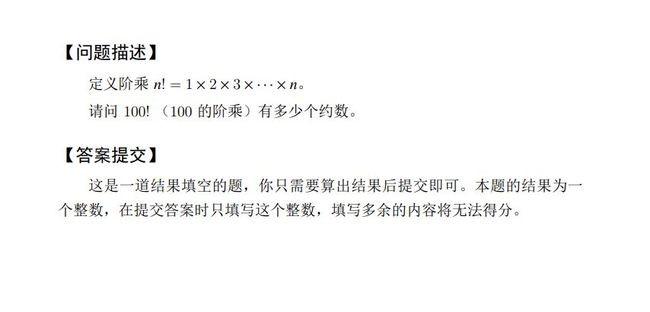【解】第十一届蓝桥杯c++b组填空题题解
前言
本次填空题偏简单,编程大题有难(keng)度(die),4个钟,1个钟ak填空,3个钟写编程大题时间还是很紧张,算法以暴力为主,并没有时间想最优解。
试题 A: 美丽的 2
#include试题 B: 扩散

读完题目,易知这是道bfs的模板题,从4个点开始,不断向四个方向扩散,唯一比较难办的是如何解决坐标为负数数组会越界的问题,比赛时我想的最直接的方法是将给定一个偏移量base,将坐标上的点进行整体的移动,但是另一种思路更加的简单,用哈希表的思想,将每个坐标映射成一个数且这个数是唯一的,然后可以用哈希表来维护出现过的坐标 ,虽然程序跑起来会比较长
#include试题 C: 阶乘约数

数论题,首先由算术基本定理我们可以给出一个数被分解后质数及其个数
N = P 1 a 1 P 2 a 2 P 3 a 3 . . . P n a n N = P_{1}^{a_1}P_{2}^{a_2}P_{3}^{a_3}...P_{n}^{a_n} N=P1a1P2a2P3a3...Pnan
其中 P i P_i Pi为质数, a i a_i ai为正整数
我们可以推出一条性质,N的约数的个数为 ( a 1 + 1 ) ( a 2 + 1 ) ( a 3 + 1 ) . . . ( a n + 1 ) ({a_1} + 1)({a_2} + 1)({a_3} + 1)...({a_n} + 1) (a1+1)(a2+1)(a3+1)...(an+1) 这里可以用组合数学 (背包思想) 的办法来解释,约数一定是由不同的质因数组成的,那么每种质数我选择若干个,假设质数 P i P_i Pi可以选0,1,2, a i a_i ai个,一共有( a i a_i ai + 1)种方法,根据乘法原理,把每种质数选择的个数相乘起来即可
#include试题 D: 本质上升序列

经典dp问题,这题和递增子序列求方案数相比,多了一个条件,相同的递增子序列只算1次,我们可以先从递增子序列求方案数(包含重复的)开始思考, f [ i ] f[i] f[i]表示以 a [ i ] a[i] a[i]结尾的字符的递增上升子序列方案数,很容易写出状态转移方程
f [ i ] = f [ i ] + f [ j ] , a [ i ] > a [ j ] , j < i < = n f[i] = f[i] + f[j], a[i] > a[j],j < i <= n f[i]=f[i]+f[j],a[i]>a[j],j<i<=n
本质不同递增子序列说白了就是同一个递增子序列只算一次,那么上式最后得出的结果一定是有重复计数的,所以我们要把这一部分剪掉,我们可以重新定义一下 f [ i ] f[i] f[i]表示以i结尾的不同递增子序列的个数,当 i < j , a [ i ] = = a [ j ] i < j, a[i] == a[j] i<j,a[i]==a[j]显然以a[i]结尾的递增子序列方案数都包含在了f[i]当中了,那么f[j]就不必再去计算i前面的递增子序列方案数了,所以碰到 i < j , a [ i ] = = a [ j ] i < j, a[i] == a[j] i<j,a[i]==a[j],break就ok了
#include试题 E: 玩具蛇

这个问题很抽象但是考场一下想到用dfs其实这题不用dfs也能做,将1-16放到格子里,时间复杂度度为 O ( 16 ! ) O(16!) O(16!),全排列问题然后用判断一下该方案是否合法, 分析问题可以得到的合法的方案即:从1出发往4个方向走,走16次,每个格子有且仅被走过一次。这里还是用dfs解吧
#include小结
本次填空题注重基础算法的应用,如简单模拟、bfs、简单数论、dfs、dp考点比较全面,读题细心一点就不会有太大问题
